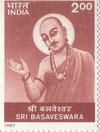History of the Kannada Literature-IV
by Dr. (Mrs) Jyotsna Kamat
First Online: January 07, 2001
Last updated on : December 07, 2024
History of Kannada Literature
Early History | Jaina
Works | Medieval Kannada
Vachana Literature | Dasa Sahitya | Epics | Modern Kannada
| Previously, A Survey of Medieval Works in Kannada |
Veerashaivism and theVachana Literature
There were Vachanakaras prior to Basavanna like Devara Dasimayya, Madara Channayya, and Sakalesha Madarasa. The revolutionary spirit and social awareness ushered in by Basavanna gave strong impetus to the composition of Vachanas attracting large numbers of devotees who belonged to different strata of society. They gave expression to their own milieu, depicting imagery and symbolism revealing different professions to which he or she belonged.
Vachanas contain the thought and experience of Vachanakaras who strived for God realization through their own vocations. Vachanas are aphoristic in form and rhythmic in style and words. The language was the spoken word of the commoners. Vachana normally means spoken word or phrase. But now it came to indicate a special type of composition which was neither prose nor verse but pithy expression. The Vachanas do have rhythm, though non-metrical. Its style became immensely popular and has its own following till today.
Basaveshwara of Koodala
Saint Poet Basaveswara
|  |
King- sage Basavanna (a.k.a. Basaveshwara) stood for equality for
all and dreamt of a casteless society. He criticized all forms of social injustice,
condemned vehemently several superstitions and animal sacrifice, and taught that the path
of devotion was the best way for self-realization. He advocated equal opportunity for
women with men in all fields: social, religious, and economic. These reforms attracted
devotees from the lower strata of society along with highly placed and
educated people as well. Thus there were shoemakers (Madara Dhulayya), cowherds (
Ramanna ), tailors ( Sujikayakada Ramitande), basketmakers ( Medara Ketayya ), and
a carpenter ( bachi Kayakada Basappa). All of them turned great devotees and
Vachanakaras. Kayakave Kailasa ![]() --work is worship -- became the mantra. Their Vachanas born
out of their respective vocations are full of imagery and liveliness.
--work is worship -- became the mantra. Their Vachanas born
out of their respective vocations are full of imagery and liveliness.
|
Cripple me, father, Translated by A. K. Ramanujan |
Akkamahadevi's Vachanas has a lyrical quality and direct personal appeal with rare poetic elements. The similes she chose have great mass appeal because they are true to life.
|
I love the Handsome One: I love Him O mother. Listen. So my lord, white as jasmine, is my husband. by Akkamahadevi Translated by A. K. Ramanujan |
With the Vachana movement, Kannada language broke the traditions of court poetry and opened avenues to one and all who aspired to express his/her innersoul. The Vachanas became common man's literature, his/her ideal and his/her medium for the following century.
History of Kannada Literature
Early History | Jaina
Works | Medieval Kannada
Vachana Literature | Dasa Sahitya | Epics | Modern Kannada
See Also:
- Modern Kannada Writers -- a treasure house of rare portraits at Kamat's Potpourri
- History of Konkani Language
- Jyotsna Kamat's Home Page
- Jai Karnataka -- Potpourri of topics on Kannada art and culture.
